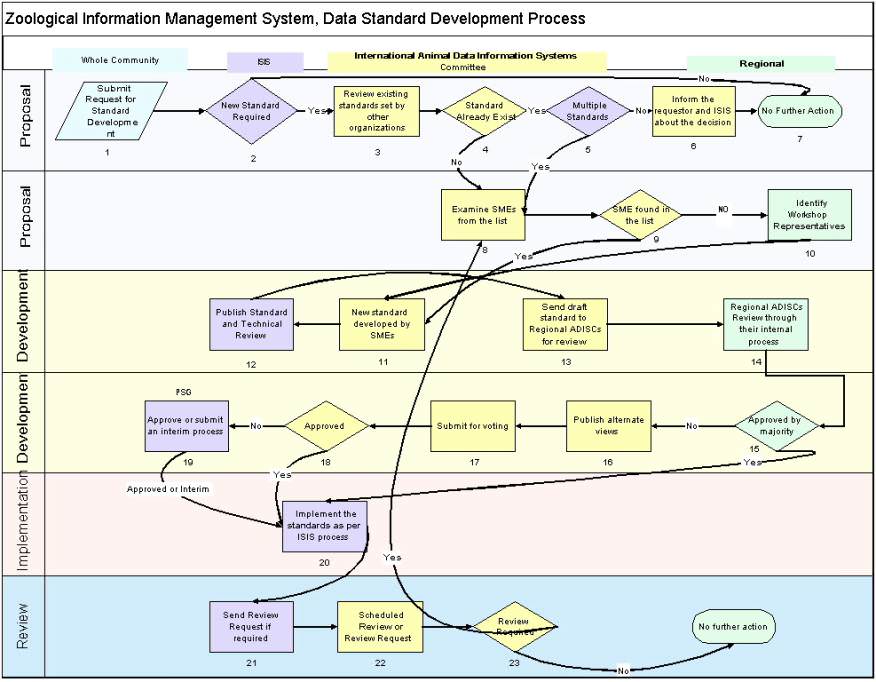The
flow chart below describes the proposed process for the development of
data standards. The flow
chart is divided into four functional areas: Proposal, Development,
Implementation and Review.
The responsible parties are listed across the top:
"Whole Community, ISIS, IADISC, Regional ADISC/committees.
Each box or step in the process could potentially be broken into
many more subprocesses. For
example, the process at the regional level is not well defined other than
noting that Regional ADISCs will review particular standards through their
internal processes, which may be an appropriate Subject Matter Expert (SME)
organization or committee or external (in the sense of external to zoo and
aquarium associations) stakeholder. This would need
to be determined by each region.

Data Standards Development Process – explanation
The text below attempts to explain each of the steps and decision points in more detail. This proposal is being sent to IADISC for review and distribution within each of the regional ADISCs.
- Submit Request for
Standard Development: Any
stakeholder can make a request for new standards or for the review of
existing standards. In the context of ZIMS it is assumed that this
process will be fast-tracked by the identification of standards
required during design workshops.
- New Standard Required
Y/N: ISIS will determine if the
request for a new standard or review of an existing one is relevant to
the database. ISIS staff
will locate, research, and prepare documentation regarding existing
standards. These existing standards may come from international or
regional documents, or may be ISO-certified standards in use by the
world community.
- Review existing
standards set by other organizations:
IADISC will review the proposal for a new standard and determine if an
existing standard can be used or there is a need for a new one.
- Standard already exists
Y/N: If no standard exists,
then the proposal is moved for action by the regional SMEs (Subject
Matter Experts).
- Multiple Standards
exist Y/N: If only one
certified standard exists, the proposed standard is circulated. If
multiple standards exist, the proposal is moved for action by the
regional SMEs.
- Inform the requestor
and ISIS about the decision: If
IADISC determines that a standard already exists and there are no
conflicting multiple standards, then the there is no further action
and the requestor is informed.
- No further action:
(no text)
- Pick SMEs from the
list: If there is a need for a
new standard or resolution regarding multiple standards, then IADISC
will pick SMEs from an existing list compiled with input from regional
ADISCs for such a purpose.
- No SME found in the
list Y/N: If appropriate SMEs
cannot be identified from the list for the particular standard, then
IADISC will send a request to the regional ADISCs to send workshop
representatives.
- Send workshop
representatives: Regional
ADISCs will identify appropriate SMEs.
This may include participants from external partnerships or
non-member institutions and individuals, regional professional
associations, conservation organizations, regulatory agencies, etc.
- New standards developed
by SMEs:
An international forum of SMEs convenes to develop a draft
standard. (This may occur in a workshop format or by some form of
electronic collaboration.)
- Publish standards and
technical review: IADISC sends
the draft standard to ISIS for technical review. ISIS will review the
standard for compliance with a predefined template, appropriate
documentation, compatibility with any existing standards, and
structural impact on the database or cost to implement.
- Send draft standards to
regional ADISCs for review: The
draft standard is sent to IADISC for circulation among regional ADISCs.
- Regional ADISCs review
through their internal process:
Each regional ADISC will coordinate the review of the draft and
utilize their particular regional process for distribution and
decision-making.
- Approved by majority
Y/N: Regional ADISCs will
either approve or reject the draft. If the draft is approved by the
regional ADISCs then it can be moved to implementation..
- Publish alternate
views: If not approved by all
regional associations, then alternative views are compiled and
published by IADISC.
- Submit for voting:
IADISC will review the alternatives and vote on approval of the
standard.
- Approved Y/N:
If approved by IADISC then the standard moves to implementation.
If a unanimous decision cannot be made for a single standard
then regional alternates must be sent to the ZIMS Project Steering
Group (PSG).
- Approve or submit an
interim process (PSG) Y/N:
The PSG will determine will review the feasibility of
implementing regional standards or implement an interim process.
- Implement the standards
as per ISIS process: The
approved standard is implemented.
- Send Review Request if
required: ISIS will generate a
periodic review of the standard if required.
- Scheduled Review or
Review Request: IADISC will
determine if there is a need to review.
- Review Required Y/N: If
no need for review, then no further action. If review is required,
then the process begins again in the Proposal stage and SMEs are
picked from a list to review the standard.
- No Further Action: (no
text)